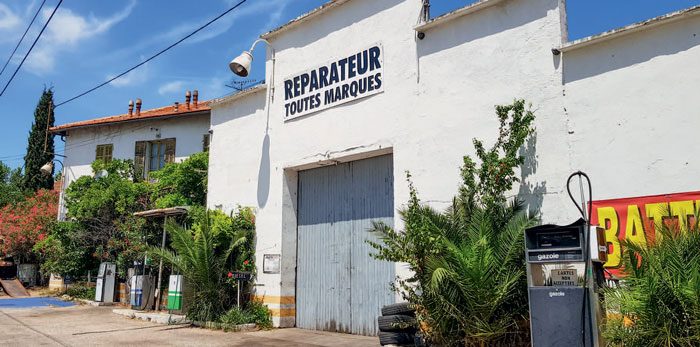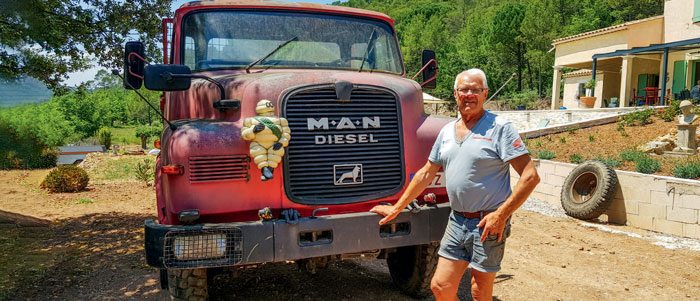INTERNATIONAL TRUCK STOP – RUST IN PEACE
If you leave the more urban areas in Southern Europe and trundle along a back road it is possible to stumble upon some historic surprises. Behind an old barn or some bushes, a real gem could be hidden – a forgotten car, truck, bus or some other mechanical contraption. Sometimes it is still in remarkable condition, at other times not more than a wreck…

Photo: Fascinating view of ‘faded glory‘ in the Spanish Girona region. This unknown bonneted truck dates from the 1930s.
Trusty workhorses that spend their last days alone somewhere in a shed, parking lot or field can still be seen regularly in countries with a dry and hot climate. The victim could be sitting in a public domain or on a piece of land that belongs to a private party, garage or scrap dealer. Be it in Europe, North America or elsewhere, some owners are not keen to see visitors on their property. However, when you are welcome, it is fascinating to stroll around a place where all kinds of mobile heritage are slowly passing away. The more unique the discovery, the greater the kick. And that half the body or the mechanicals are missing does not make a difference when it concerns a model or make that has, long ago, disappeared from the market.

Photo: Looks like a scene from the past but this is in the South of France today!

Photo: Not much is left of this Renault Galion from the 1950s!
As far as truck brands are concerned, the European transport scene is nowadays quite boring. Contrary to New Zealand, the market is dominated by only seven European names, not counting a few specialists that produce a limited number of chassis for niche markets. Apart from the latter, due to EU regulations most truck and trailer combinations look the same. That is also the case for superstructures and liveries. Gone are the colourful cargo trucks that plied the highways and byways of notably Southern Europe some 30 or 40 years ago. Take France, for example, where respected names such as Berliet, Bernard, Latil, Unic and Willème became only a memory by the turn of the century. Only very occasionally an elderly model can be spotted on the road that has been lovingly refurbished by its owner.

Photo: A nicely refurbished Jailbar Ford and Berliet GLA brighten up a classic truck festival near Paris.
Or, more often, at one of the classic truck events that are held each summer all over Europe. At such meets the owners share often fascinating stories about the discovery and the restoration of their pride and joy. But the chance to find a genuine old-time commercial vehicle becomes more difficult with the years. Today, since the economy has experienced an enormous setback worldwide due to the coronavirus crisis, few people can afford to keep up an expensive hobby. Even so, in more remote areas there are many worthwhile vehicles from the past to be rescued. But be careful entering private land without first asking permission – most people living in the country have a watchdog to protect their property. And so do junk yard owners, and used truck dealers. It helps to speak a few words in the local tongue. This way you also get to know something more about the derelict vehicle. Such as what make, model and year of build it is, and how it ended up there. Strolling around all kinds of ancient vehicles that are slowly rotting away is both an exciting and comforting experience. The term ‘automobile graveyard‘ is very appropriate.

Photo: This big WWII Ward LaFrance Model 1000 was spotted in a junkyard in the Verdon more than 75 years later.

Photo: Contractor Romain Vogels still uses his 1983 MAN 4×4 tipper for local haulage work.
However, due to stringent European environmental regulations, it‘s becoming more difficult to leave discarded equipment in the open field. And that sometimes even applies to private ground, nowadays the case in all Mediterranean countries. Also, gone are the days that you could still see numerous old trucks working hard. If you crossed the Pyrenees into Spain some 30 or 40 years ago, it was still the Valhalla of commercial vehicles. The national routes were crammed with noisy and smoky vintage diesel wagons. They trundled behind each other like elephants, along oil- and rubber-stained two-lane highways, across endless plains, over steep mountain passes, and through picturesque medieval villages. Most of these routes are now banned for heavy through traffic. Trucks are forced to use the new multi-lane toll roads. In the 1960s and 70s Spain was a truck-spotter‘s paradise, with – elsewhere seldom seen on the continent – Barreiros, Ebro, Pegaso and locally built Dodge and Leyland trucks doing their daily duties. The majority of these wagons are owned by small transport companies and owner operators.

Photo: A complete rebuild of a wreck such as this 1927 International requires a lot of patience (and money!).

Photo: View of a trio of classic trucks in a French mountain village. The flatbed is a locally built Ford from the 1950s.

Photo: Spanishmade, beautifully restored, Dodge Kew and Leyland Comet 5-tonners at the Camiones Clasicos Show.
Noisy and bellowing smoke, the diesel ‘camiones‘ [truck or wagon] were recognisable for their magnificent colours, chromed add-ons, and typical Spanish sun visors that proudly displayed the owner‘s name. The steel or wooden cargo body was often custom built and just as colourful as the truck itself. When the country joined the European Union in 1986 a lot changed, and not all for the better. Around the turn of the century transportation by road was a completely different picture. Taken over by multinationals such as Iveco and Renault, the Pegaso and Barreiros/Dodge names disappeared from the truck front. Today, you have to look very hard to find, for example, a Pegaso still in working order. Unfortunately, contrary to countries like Germany, France, Holland and the UK, there is only some recent interest in preserving old commercial vehicles on the Iberian Peninsula. But it must be said that a few larger hauliers are now showing an interest in saving and rebuilding historic motorised vehicles. There are even some annual oldtimer events now, such as Camiones Clasicos, that are held at various locations.
So, when you are a truck buff and spend your holiday in this part of the world, make sure you leave that cosy terrace or sunny beach for a couple of hours to have a closer look at some of Europe‘s rarest and more colourful diesel ‘dinosaurs‘.

Read more
Meeting Volvo’s VNL
0 Comments13 Minutes
A yank with a Dutch touch
0 Comments8 Minutes
Talking Double Dutch
0 Comments12 Minutes
Visiting the vikings
0 Comments1 Minute





